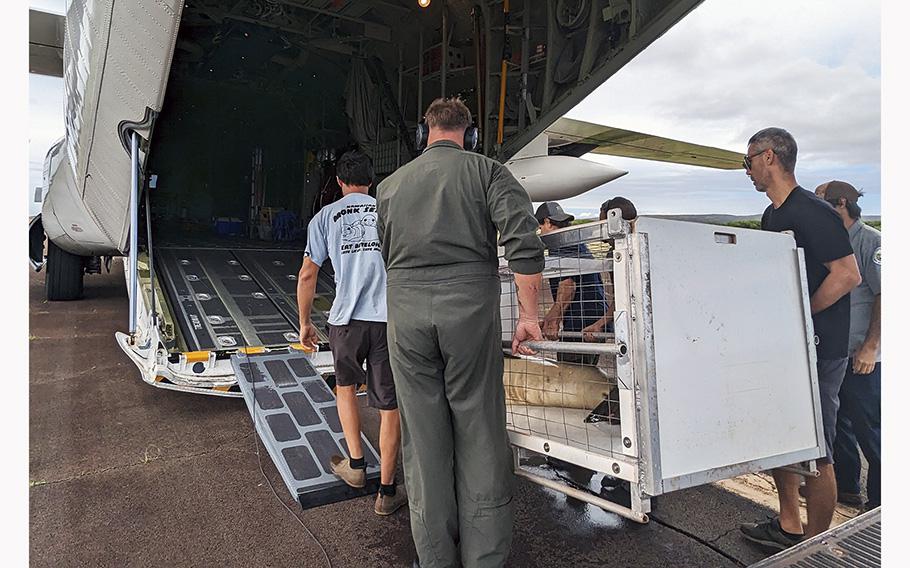
The U.S. Coast Guard Hawaii Pacific helped rescue and transport a female Hawaiian monk seal RL68, which is now receiving diagnostic testing and care at The Marine Mammal Center’s Ke Kai Ola monk seal hospital. (NOAA/Facebook)
(Tribune News Service) — A well-known Hawaiian monk seal on Molokai that appeared sickly is now getting care at a specialized hospital in Kailua-Kona.
In April a community member first alerted wildlife officials that monk seal RL68, a female that frequents Molokai's west-side beaches, was losing a lot of weight and appeared to be losing energy as weeks progressed.
The National Oceanic and Atmospheric Administration, along with its nonprofit partner Hawaii Marine Animal Response on Molokai, decided intervention was needed and initiated a rescue operation.
With luck, monk seal RL68 was spotted the day of the rescue operation and transported, with the help of the U.S. Coast Guard, to The Marine Mammal Center's Ke Kai Ola hospital for monk seals.
Dr. Sophie Whoriskey, the center's Hawaiian Monk Seal conservation veterinarian, said RL68 was in poor body condition for a 4-year-old seal and deteriorating quickly, so timely intervention was necessary for her survival.
"For an endangered species like the Hawaiian monk seal, every patient matters," she said. "We are grateful to the community for their support and our partners for their rapid response ensuring the best chance for her to return to her ocean home."
With only about 1,500 left in the wild, Hawaiian monk seals are one of the most endangered seal species in the world, protected by state and federal laws.
It's also peak pupping season, and NOAA Fisheries recommends maintaining a distance of least 150 feet from monk seal moms and pups both on land and in the water. For other seals, NOAA recommends keeping a distance of at least 50 feet.
Mother seals can be protective of their pups, officials said, and are more likely to exhibit territorial behavior around them. They can — and have — bitten humans perceived as threat.
While Hawaiian monk seal Kaiwi is nursing her pup at Kaimana Beach on Oahu, for instance, NOAA strongly recommends the public use other beaches.
Kalaupapa National Historical Park in late April also announced the arrival of its first monk seal pup, with photos posted to Facebook. A beachgoer reported the pair to the park's marine ecologist. Park officials there also remind the public to give the mom and pup plenty of space.
Monk seal RL68, meanwhile, has been showing improvement at the center, which is providing her with a calorie-rich diet of sustainably caught herring, along with fluids to boost her hydration and medications for gastroenteritis.
The veterinary team has taken X-rays and submitted blood samples to check for signs of disease, but these will take several weeks to process. When she is ready, officials will return her to Molokai.
Since 2014 the center has rehabilitated and released 40 monk seals, most of which have been rescued from and returned to the Northwestern Hawaiian Islands in partnership with NOAA.
(c)2023 The Honolulu Star-Advertiser
Visit The Honolulu Star-Advertiser
Distributed by Tribune Content Agency, LLC.